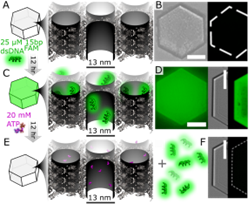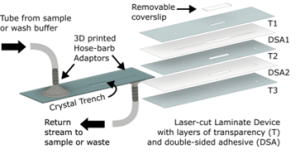The projects described below are featured to:
(a) highlight the variety of research opportunities available in the CSU Chemistry program, and
(b) link less-experienced undergraduate researchers to thoughtfully constructed assignments, with the aim to maximize discoveries and research productivity.
Please note: prospective REU participants are welcome to apply to work with any of our participating faculty.
Mentors: Prof. Jeff Bandar and Prof. Eugene Chen
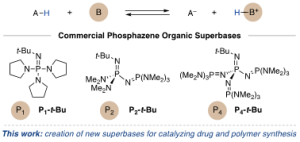
Project Description:
Organic superbases are neutral compounds that possess very strong basicity and display unique properties compared to traditional anionic bases. The Bandar and Chen Groups at CSU employ these bases as catalysts for the synthesis of bioactive small molecules and recyclable cyclic polymers, respectively. These protocols rely on commercially available superbases, but to improve this chemistry, the invention of new superbases is critical. Students involved in this project will be mentored by senior graduate students in the Bandar and Chen labs to accomplish this task. The research will involve the synthesis of new superbases, analysis of their basicity and optimization of their catalytic performance for the sustainable synthesis of pharmaceuticals and recyclable polymers.
Description of REU Student Activities:
- This student will work with their mentors to design and prepare new superbases, then test and optimize their performance for catalyzing the synthesis of small molecules and polymers
- Students will conduct daily laboratory work, including learning proper and safe techniques for reaction setup, reaction analysis, compound purification and the use of all associated instruments and equipment
- Individual mentorship from senior graduate students on planning, conducting and analyzing organic synthesis experiments
- Participation in and presentations at Bandar and Chen group meetings
- Practice activities and preparation for public scientific presentations and writing
Mentors: Prof. Debbie C. Crans and Prof. Dean C. Crick
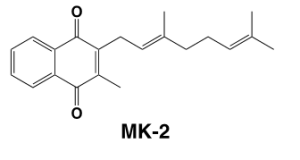
Project Description:
Lipoquinones (menaquinones (MK) and ubiquinones (UQ)) are electron carriers responsible for shuttling electrons between the proteinaceous membrane-bound electron donors and acceptors in biological electron transport systems (ETS). There are considerable variations in the structures of microbial MK, which consists of an naphthoquinone headgroup and isoprenyl sidechain that varies in length, degree and position of saturation by species. Below we show the structure of MK2 that contains the naphthoquinone head group and two isoprene units. We are investigating the hypothesis that microorganisms’ oxidative phosphorylation is adapted to evolutionarily conserved variations in MK structure and some structures will support phosphorylation. We are synthesizing and measuring their structure-activity relationship as substrates for lipoquinone reducing dehydrogenases activity.
Description of REU Student Activities:
- The synthesis of truncated menaquinone
- Purification of the truncated menaquinone
- Characterization of the solution structure using 1D NMR (1H NMR, 51V NMR) and 2D COSY, NOESY and ROESY NMR spectroscopy
- Determine the activity of the lipoquinones with reducing dehydrogenases
- Participation in in-person group meetings with the Crans and Crick groups at CSU
Recent reference of related chemistry: Electron transport lipids fold within membrane-like interfaces” Margaret M Braasch-Turi, Jordan T Koehn, Kateryna Kostenkova, Cameron Van Cleave, Jacob W Ives, Heide A Murakami, Dean C Crick and Debbie C Crans Front. Chem., 2022, 10, p Article 827530 (1-17) doi: 10.3389/fchem.2022.827530. (Jacob W Ives is an undergraduate co-author)
Mentors: Prof. Debbie C. Crans and Prof. Megan Hill
Project Description:
Hydrophobic Schiff base catecholate non-innocent vanadium complexes have recently been reported to have in vitro efficacy against platinum-resistant glioblastoma (T98g) cell lines see figure below. We have recently filed a patent on the application of this class of compounds in several different cancer cell lines. In this project we propose to develop hydrogel formulation for administration of these compounds. This proposed study is therefore to prepare the compound, the hydrogel and the hydrogel-vanadium compound mixture. Specifically, we plan to determine if the stability of the compound in the hydrogel is improved and hence will impact administration of the compounds in future animal studies.
Description of REU Student Activities:
- The synthesis of hydrophobic Schiff base catecholate complexes and characterizing these complexes
- The synthesis of hydrogels and characterizing these
- Synthesis of hydrogels containing the Schiff base catecholate complex
- Determining the stability in the hydrogel and compare this with the stability in aques and organic solutions
- Participation in in-person group meetings with the Crans and Hill groups at CSU
Recent reference of related chemistry: “Vanadium(V) pyridine-containing Schiff base catecholate complexes are novel lipophilic, redox-active and selectively cytotoxic in glioblastoma (T98g) cells” Kateryna Kostenkova, Aviva Levina, Drew A. Walters, Heide A. Murakami, Peter A. Lay, Debbie C. Crans Chem. A Eur. Journal 2023 in press. Inside Cover was published and image is shown below..
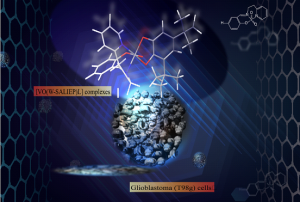
Mentors: Prof. Debbie C. Crans, Prof. Adam Chicco and Prof. Peter A. Lay (University of Sydney, Australia)
Project Description:
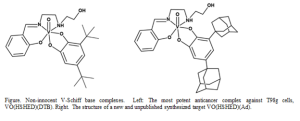
Hydrophobic Schiff base catecholate non-innocent vanadium complexes have recently been reported to have in vitro efficacy against platinum-resistant glioblastoma (T98g) cell lines. Bulky hydrophobic substituents on the catecholate ligand increase hydrolytic stability of the complexes under the assay conditions. We propose the synthesis of novel complexes within this group of compounds as well as testing their effects in mitochondria. These compounds will be synthesized, the effects compounds tested for their effects in mitrochondria in the Chicco laboratory and their anticancer activity by our colleagues Peter A. Lay at the University of Sydney, Australia. The compounds will be sent to the University of Sydney and tested and the testing of these compounds will be discussed each week in a virtual meeting.
Description of REU Student Activities:
- The synthesis of sterically hindred catechols such as the 3,5-di-adamantyl catechol.
- The synthesis of vanadium Schiff base catecholare comples
- Characterization of these complexes using 1D NMR (1H NMR, 51V NMR) and 2D COSY, NOESY and ROESY NMR spectroscopy
- Testing of these compounds with their effects in mitochondria
- Participation in in-person group meetings with the Crans and Chicco groups at CSU and virtual group meetings with Peter A. Lay and Aviva Levina at the University of Sydney
Recent reference of related chemistry: “Vanadium Chloro-Substituted Schiff Base Catecholate Complexes are Reducible, Lipophilic, Water Stable, and Have Anticancer Activities” Heide A. Murakami, Canan Uslan Yigit, Allison A. Haase, Jordan T. Koehn, Adriana P. Vieira, D. Jackson Gaebler, John Hagan, Cheryle N. Beuning, Nicholas Proschogo, Aviva Levina, Peter A. Lay, Debbie C. Crans, Inorg. Chem., 2022, 61(51), 20757-20773. DOI: 10.1021/acs.inorgchem.2c02557 (D. Jackson Gaebler and John Hagan are undergraduate co-authors)
Mentors: Prof. Chuck Henry and Prof. Chris Snow
Project Description:
This project will develop an approach for the capture and electrochemical detection of circulating tumor DNA (ctDNA) from urine samples as a tool for early cancer detection and treatment efficacy monitoring. To maximize sensitivity, it is desirable to first accumulate trace biomarkers from relatively large volumes of urine into a small volume. We envision a device that maximizes volumetric amplification using an inexpensive pump to circulate urine through a tiny bed of particles with ultra-high affinity for DNA. Specifically, this project will demonstrate that porous protein crystals engineered in the Snow lab can be incorporated into microfluidic devices engineered in the Henry lab, and in this context, can preconcentrate ctDNA.
Description of REU Student Activities:
- fabricate prototype devices
- synthesize batches of DNA-adsorbent protein crystals
- devise methods for reliable repeatable loading of crystals into devices
- quantify DNA adsorbed by crystal-laden devices attached to pumps
- quantify DNA released by crystal-laden devices in elution buffer
Mentors: Prof. Megan Hill and Prof. Garett Miyake
Project Description:
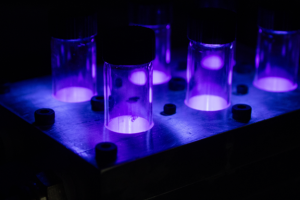
Photoredox catalysis is a powerful approach to efficiently synthesize molecules and materials through harnessing the energy from light to drive a chemical transformation. Furthermore, photoredox catalysis enables unique reaction pathways that allow for the synthesis of new chemicals in more direct routes. This project will focus on the development of organic photoredox catalysts and use of these catalysts in synthetic organic chemistry methodologies.
Description of REU Student Activities:
- Synthesis of organic photoredox catalysts
- Characterization of organic photoredox catalysts using spectroscopy and electrochemistry
- Use of photoredox catalysts to develop synthetic organic methodologies
- Participate in Hill and Miyake group meetings
Mentors: Prof. Garett Miyake and Prof. Seonah Kim
Project Description:
Plastic waste is an urgent issue present across the globe. Copolymers in particular present a challenging recycling problem due to their complex chemical and morphological properties, with few tools to predict copolymer properties in silico. In this project, we will explore copolymer properties through both computation and experiment towards improving recyclable copolymers. The REU student will use cutting-edge computational methods such as density functional theory (DFT) and machine learning (ML) to model real-world copolymers, with a particular focus on property prediction. The REU student will also gain valuable experience in experimental polymer chemistry, using standard air-free methods to synthesize and characterize a wide variety of recyclable copolymers.
Description of REU Student Activities:
- Polymer informatics and machine learning
- Recyclable polymer design and synthesis
- Python programming and data science
- Polymer property prediction and experimental polymer analysis

Mentors: Prof. Nancy Levinger and Bridget Gourley (DePauw University)
Project Description:
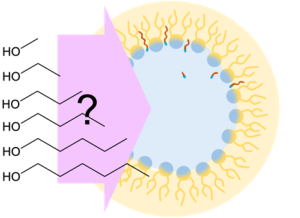 Self-assembled structures occur commonly in chemistry and biology from micelles to liposomes. This project explores how small, water-soluble molecules impact the self-assembly of reverse micelles. Students will prepare reverse micelles adding water soluble molecules such as straight chain alcohols to assess how and when molecule partition between aqueous nanodroplets and surfactant components and will characterize and interpret data from light scattering, NMR and other spectroscopic methods. Profs. Levinger and Gourley have engaged undergraduate and graduate students from Colorado State University and DePauw University together for the past three years and are excited to expand to REU
Self-assembled structures occur commonly in chemistry and biology from micelles to liposomes. This project explores how small, water-soluble molecules impact the self-assembly of reverse micelles. Students will prepare reverse micelles adding water soluble molecules such as straight chain alcohols to assess how and when molecule partition between aqueous nanodroplets and surfactant components and will characterize and interpret data from light scattering, NMR and other spectroscopic methods. Profs. Levinger and Gourley have engaged undergraduate and graduate students from Colorado State University and DePauw University together for the past three years and are excited to expand to REU
Description of REU Student Activities:
- Prepare reverse micelles including a straight chain alcohol, e.g., methanol, ethanol, etc.
- Characterize reverse micelle size using dynamic light scattering, 1D and 2D NMR and potentially other spectroscopies;
- Compare and contrast the impact of the alcohol on the particle formation, size, and molecular interactions;
- Collaborate with students working on other aspects of the project to create a comprehensive description of molecular interactions between alcohols and reverse micelles.
Mentors: Prof. Jamie Neilson and Prof. Amy Prieto
Project Description:
To enable next-generation, beyond Li-ion batteries, we require new materials. For example, sodium is extremely abundant and inexpensive, and sodium ion batteries have the potential to replace lithium in myriad applications. However, we cannot simply replace Li with Na in existing materials used in litihium ion batteries. In this project, we are taking advantage of new synthetic solid-state chemistry to synthesize and test new materials for the development of sodium ion batteries.
Description of REU Student Activities:
- Synthesis of new ceramic materials using high-temperature furnaces.
- Characterization of materials using diffraction and electron microscopy.
- Construction of electrochemical cells
- Electrochemical testing of materials in battery half-cells.

Mentors: Prof. Robert Paton and Prof. Seonah Kim
Project Description:
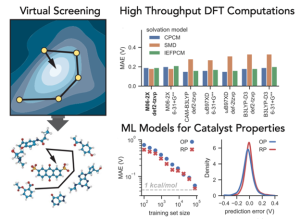 In this project, the REU student will develop an automated computational workflow for the systematic evaluation and prediction of candidates for high efficiency organic photocatalysts. These virtual screening studies will use density functional theory (DFT) calculations to obtain frontier molecular orbitals and photophysical properties, including excitation energies, dipole moments, and redox potentials. The newly generated data will be used to train machine learning algorithms to identify new structure–property relationships between molecular ground- and excited-states for prospective organic photocatalysts that can be applied to challenging synthetic applications.
In this project, the REU student will develop an automated computational workflow for the systematic evaluation and prediction of candidates for high efficiency organic photocatalysts. These virtual screening studies will use density functional theory (DFT) calculations to obtain frontier molecular orbitals and photophysical properties, including excitation energies, dipole moments, and redox potentials. The newly generated data will be used to train machine learning algorithms to identify new structure–property relationships between molecular ground- and excited-states for prospective organic photocatalysts that can be applied to challenging synthetic applications.
Description of REU Student Activities:
- Python programming and cheminformatics
- DFT calculations of ground and excited state structures and properties
- Development of structure-property relationships for organic photocatalysts
Mentors: Prof. Matthew Shores and Prof. Anthony Rappe
Project Description:
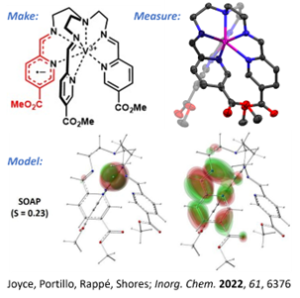 Spin crossover is an energetically balanced phenomena capable of measuring small binding energy differences. Metal podand complexes with pendant groups will be used to study the impact of solvent on intramolecular binding events including hydrogen bonding, halogen bonding, and lipophobic fluorocarbon binding. Students on this project gain exposure to all aspects of making, measuring, and modeling coordination complexes. A recent example of our long-term collaboration is depicted below.
Spin crossover is an energetically balanced phenomena capable of measuring small binding energy differences. Metal podand complexes with pendant groups will be used to study the impact of solvent on intramolecular binding events including hydrogen bonding, halogen bonding, and lipophobic fluorocarbon binding. Students on this project gain exposure to all aspects of making, measuring, and modeling coordination complexes. A recent example of our long-term collaboration is depicted below.
Description of REU Student Activities:
- Synthesize and structurally characterize new coordination complexes
- Study the temperature dependence of the magnetism of these complexes
- Compute the structures and magnetic properties of these complexes
Mentors: Prof. Justin Sambur and Prof. Amber Krummel
Project Description:
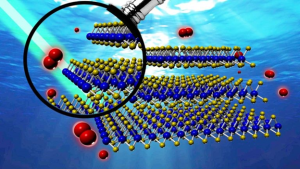 Atomically-thin 2D semiconductors represent an exciting class of light absorbers for solar energy conversion applications because they absorb a large fraction of the solar spectrum (10%) despite their atomically-thin structure and the photo-excited electrons exist immediately at an interface to drive a photocatalytic reaction. You will explore how we can optimize 2D semiconductor photocatalysts to drive the hydrogen evolution reaction from liquid water, which represent a holy grail in renewable energy science.
Atomically-thin 2D semiconductors represent an exciting class of light absorbers for solar energy conversion applications because they absorb a large fraction of the solar spectrum (10%) despite their atomically-thin structure and the photo-excited electrons exist immediately at an interface to drive a photocatalytic reaction. You will explore how we can optimize 2D semiconductor photocatalysts to drive the hydrogen evolution reaction from liquid water, which represent a holy grail in renewable energy science.
Description of REU Student Activities:
- Fabricate 2D semiconductor electrodes
- Modify the surface structure of 2D materials with co-catalysts
- Use electrochemical methods to characterize the performance of 2D semiconductors for the hydrogen evolution reaction
- Spectroscopic characterization of 2D semiconductor materials
- Spectroscopic characterization of photoelectrochemical cells
Mentors: Prof. Justin Sambur and Prof. Jamie Neilson
Project Description:
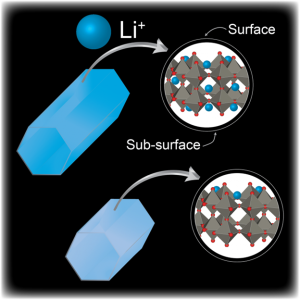 Transition metal oxide compounds are exciting alternatives to graphite for high-rate energy storage applications (e.g., power drills). Of all the candidate materials, “Wadsley-Roth” compounds with multiple transition metals (e.g., Mo, W, Nb, V) offer extremely fast charge/discharge rates and the ability to store more than 1 electron per transition metal site. However, these compounds contain “Wadsley defects” that likely trap charge, which diminishes the battery’s ability to store charge over time. This project aims to control the concentration and type of Wadsley defects in a series of niobium tungsten oxide compounds.
Transition metal oxide compounds are exciting alternatives to graphite for high-rate energy storage applications (e.g., power drills). Of all the candidate materials, “Wadsley-Roth” compounds with multiple transition metals (e.g., Mo, W, Nb, V) offer extremely fast charge/discharge rates and the ability to store more than 1 electron per transition metal site. However, these compounds contain “Wadsley defects” that likely trap charge, which diminishes the battery’s ability to store charge over time. This project aims to control the concentration and type of Wadsley defects in a series of niobium tungsten oxide compounds.
Description of REU Student Activities:
- Synthesize transition metal oxide compounds using a high temperature furnace and/or microwave.
- Characterize the structure using X-ray diffraction and electron microscopy.
- Construct Li-ion battery cells.
- Characterize the charge-discharge performance of the anode materials.
Mentors: Prof. Jean Chung and Prof. Nancy Levinger
Project Description:
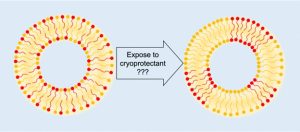 Biological membranes comprise a range of molecules, including phospholipids, glycolipids, sterols, as well as proteins, and sugars, and their nonuniform spatial distribution is an important physiological feature. Many biologically active molecules, such as antimicrobial agents and anesthetics are known to work by altering these spatial distributions. How cryoprotectants, such as DMSO and glycerol, help cells survive freezing is not well understood, but it is postulated that it involves modulating the physical properties the cell membrane. This project will explore whether cryoprotectants, like antimicrobial agents and anesthetics, can shift the spatial distribution of membrane lipids. To answer this question, the effect of DMSO and glycerol on the phase separation behavior of a model membrane will be explored.
Biological membranes comprise a range of molecules, including phospholipids, glycolipids, sterols, as well as proteins, and sugars, and their nonuniform spatial distribution is an important physiological feature. Many biologically active molecules, such as antimicrobial agents and anesthetics are known to work by altering these spatial distributions. How cryoprotectants, such as DMSO and glycerol, help cells survive freezing is not well understood, but it is postulated that it involves modulating the physical properties the cell membrane. This project will explore whether cryoprotectants, like antimicrobial agents and anesthetics, can shift the spatial distribution of membrane lipids. To answer this question, the effect of DMSO and glycerol on the phase separation behavior of a model membrane will be explored.
Description of REU Student Activities:
- Prepare giant unilamellar vesicles (GUVs) as model membranes;
- Visualize GUVs using confocal fluorescence microscopy;
- Measure the miscibility transition temperature (Tm) of phase-separating GUVs;
- Determine the changes in miscibility transition temp Tm of GUVs exposed to increasing DMSO and glycerol concentrations.
